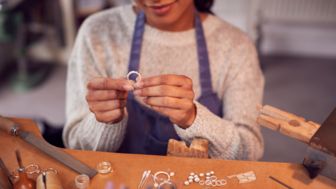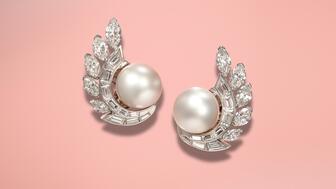Interior designer Athena Calderone looked to decor from the 1920s and 1930s when crafting her first fine jewelry collection.
Forget Millennials, Meet the ‘Midult’
Generation X females between the ages of 35 and 55 have an awful lot of buying power, but experts say they’re being neglected in the fine jewelry market.
New York--Millennial spending habits have been discussed and analyzed ad nauseam over the past several years, and, according to experts, this laser focus may be to the detriment of retailers.
At the Vicenzaoro trade show held in January, Paola De Luca, creative director of trend forecasting company Trendvision, emphasized a different demographic of shoppers that she contends have been neglected by the jewelry industry: the “midult.”
The midult is a woman De Luca describes as being between the ages of 35 and 55 and having spending power.
“When we are 35 to 55, or even 60,” De Luca explained, “we have more money. We already have the basics (in our wardrobe). Now we want the collector piece and we are willing to spend more money for it.”
A midult essentially describes a Generation X female, born between 1960 and 1980.
After millennials and baby boomers, Gen X is the third largest generation in America, according to a report by media management software company Centro. They make up 25 percent of U.S. adults at a population of 60 million.
(Though Centro’s study doesn’t break down the demographic group into percentage of females versus males, in MetLife’s latest study on the group done in 2009, the firm had it split pretty evenly at 50-50).
Centro cites a statistic from an American Express and Harrison Group study, saying that Gen X represents 29 percent of net worth dollars and 31 percent of total income dollars in the country, making it the generation with more spending power than any other.
The term “midult” is trademarked by a British media website of the same name that caters content to middle-age women. (According to De Luca, these women make up the most powerful consumer group in the U.K., with eight million falling into this category.)
In its mission statement, The Midult website says it represents, “a new definition for a new generation … We wanted to take a fresh look at the power and potential of women like us: funny, digitally literate, and extremely anxious.”
They’re definitely correct on the digitally literate aspect.
While not raised with the internet, Gen X has embraced it wholeheartedly. According to trend forecasting company WGSN, 84 percent of British 35- to 44-year-olds are daily internet users, compared to 82 percent of British millennials.
And earlier this year, The New York Times published a story on the results of a Nielsen study that found that
“The digital impact from millennials has worked its way upstream to older demographics, and it is key for retailers and manufacturers to understand the giant digital footprint this segment maintains,” said Ben Smithee, CEO of digital marketing consultancy The Smithee Group.
The Self-Purchasing Customer
While luxury markets continuously look for ways to connect with millennials who prioritize spending on experiences, the fine jewelry industry may be better served by paying attention to their generational predecessors.
“In my view, the ‘midult’ woman is the most powerful and overlooked customer of fine jewelry today,” said Amanda Gizzi, Jewelers of America’s director of public relations and events. “She has been in the work force for over fifteen years and is established in her career. She makes her own money and isn’t afraid to spend some of it on herself.”
As retirement becomes more delayed, the midult consumer only gains strength.
“The digital impact from millennials has worked its way upstream to older demographics, and it is key for retailers and manufacturers to understand the giant digital footprint this segment maintains.”--Ben Smithee, The Smithee Group.Their purchasing power can be shown in examples such as that of Moda Operandi, the e-commerce company that specializes in online “trunk shows” and allows customers to pre-order looks straight off fashion runways. According to De Luca, the midult is the target woman for the luxury e-tailer.
“(Moda Operandi products are) selling online for thousands of euros or dollars, and they’re targeting these women. Yes, there’s a millennial market, but very few girls who are 25 years old can buy a $5,000 dress,” she said.
In its “The Faces of the New Jewelry Consumer” report published last September, luxury and jewelry consumer market research firm MVI Marketing cited a study conducted by American Express and the Harrison Group that said a quarter of women in households with at least $100,000 of discretionary income had purchased jewelry for themselves, not just for an event.
“The self-purchasing woman is being ignored or underserved by the traditional jewelry industry and as such she’s going elsewhere to purchase jewelry, not in traditional specialty jewelry retail stores but in department stores and non-traditional spaces,” MVI CEO Marty Hurwitz said.
Hurwitz noted that a self-purchasing midult buys to accessorize and is doing so with pieces that are trendy, colorful and retail for between $95 and $995, with the younger Generation X consumers purchasing at the low end of that price range, and vice versa.
Yet traditional jewelry stores lack color, he added, because white diamond jewelry makes up such a large part of inventory. He said there is also an absence of styles that use color at price points the majority of self-purchasing women want to buy.
Hurwitz thinks that the fine jewelry industry can learn from other retail sectors such as shoes.
“The same self-purchasing consumer is buying four to six pairs of shoes a year on average from an array of different stores and online vendors and at a wide range of price points. Jewelry has done nothing to go after that woman. We can’t even get them to buy one product a year,” Hurwitz said.
“We need to find ways to cater to what is a very significant spending population that is willing to spend on shoes and handbags and belts and clothing consistently throughout the year. They just don’t really spend that much on jewelry because nobody is inviting them to do it.”
Finding Solutions
With generations spanning 20 years, there are, of course, nuances to be found within demographics.
Smithee explained that millennial lifestyle trends, like living at home longer, also are reflective of those at the younger end of the Generation X spectrum, a factor on which jewelers can capitalize.
“We need to find ways to cater to what is a very significant spending population that is willing to spend on shoes and handbags and belts and clothing consistently throughout the year. They just don’t really spend that much on jewelry because nobody is inviting them to do it.”-- Marty Hurwitz, MVI“You have a great hybrid of older millennials, now in their mid-30s, and younger Gen Xers who provide a large set of disposable income,” he said. “This cohort represents the most pivotal changes in life stages when it comes to opportunities for jewelers to create a meaningful relationship. From delayed marriages, child birth, anniversaries and self-purchasers, this segment provides the most opportunity for jewelers to convert sales now.”
Hurwitz suggested looking to brands that are finding success--like Kendra Scott, Alex and Ani, Pandora and the Australian Emma & Roe--and emulating their businesses, which rely on collecting, layering and stacking jewelry.
JA’s Gizzi, meanwhile, stressed that midults rely both on online shopping and in-person store experiences.
RELATED CONTENT: Why Omnichannel Retail is Key to Success in 2017
“Like most generations today, midult women are researching and shopping online, so having a strong web and social media presence is a no-brainer,” she said. “However, don’t overlook the power of having an in-person presence in the community. They are more likely to have loyalty to those who are in front of them and to whom they have a personal connection. These women are the gift givers. They want to treat those around them with special gifts and they are also more likely to treat themselves too.”
They’re also loyal to brands.
A 2011 Wall Street Journal article on the phenomenon of the self-purchasing customer concluded that stocking trusted brand names, from Todd Reed to Ippolita, is key to earning these consumers’ trust.
Experts interviewed for this article agree that millennial and even Generation Z spending habits should be paid attention to, but so should the buying patterns of the generation that came before them.
Gizzi concluded, “(The midult) grew up before the rise of the internet, yet is young enough to be fully immersed in all technological advancements. She expects high levels of customer service and rewards the stores and brands who offer it.
“Most importantly, she grew up with parents who deeply loved jewelry and all it stands for. That love was likely passed down to her and if the jewelry industry treats her well, she will pass that love down to her children.”
The Latest

During a call about its full-year results, CEO Efraim Grinberg discussed how the company is approaching the uncertainty surrounding tariffs.

The free program provides educational content for jewelry salespeople and enthusiasts to learn or refresh their diamond knowledge.

The feedback will be used to prepare other jewelers for the challenges ahead, the organization said.


The online sessions are designed to teach jewelers to use AI tools like ChatGPT and Claude to grow their business.

The “United in Love” collection offers tangible mementos of hearts entwined with traditional and non-traditional commitment heirlooms.

Bench jewelers spend years honing their skills, Jewelers of America’s Certification validates their talents.

The announcements follow a tumultuous start to 2025 for WJA, which saw a wave of resignations following controversial statements about DEI.

Editor-in-Chief Michelle Graff answers questions about how the new taxes levied on countries like India and China will impact the industry.

Kenewendo, Botswana’s minster of minerals and energy, discusses closing the deal with De Beers and the work that was missed along the way.

The historic fancy vivid blue diamond set to headline Christie’s Geneva sale next month could sell for up to $50 million.

LVMH CFO Cécile Cabanis also discussed the effects of tariffs so far.

The “Mad Men” and “The Morning Show” star steals jewelry, art, and handbags from his wealthy neighbors in “Your Friends & Neighbors.”

The organization has reelected Kalpesh Jhaveri as president.

An investigation found that the former managing director of Movado’s Dubai branch overstated and prematurely recorded sales.

The collection pays tribute to the Japanese philosophy of Ma, studying balance, stillness, and the interplay between presence and absence.

Mari Lou’s Fine Jewelry in Orland Park, a suburb of Chicago, is closing its doors.

GIA’s labs in Dubai and Hong Kong are now accepting larger diamonds in light of the “logistical challenges” presented by the new tariffs.

These earrings by Van Cleef & Arpels, featuring the same design as a pair worn by Princess Grace, are up for auction at Woolley & Wallis.

Two experts share how artificial intelligence tools can help retailers run a more efficient business.

Kentaro Nishimura, who has been with the pearl company since 1997, has been promoted to president and CEO of Mikimoto America.

“America Telling Time: 150 Years of Bulova” explores the storied history of the American watchmaker.

An across-the-board tariff of 10 percent remains in place for all U.S. trading partners, except China.

Brigette Pheloung and Tania Sarin, and their mothers, star in the campaign wearing medallions they co-designed.

LeVian is remembered for her unwavering commitment to her family, community, and helping others.

The retail show is open to the public and will run July 24-27.



























